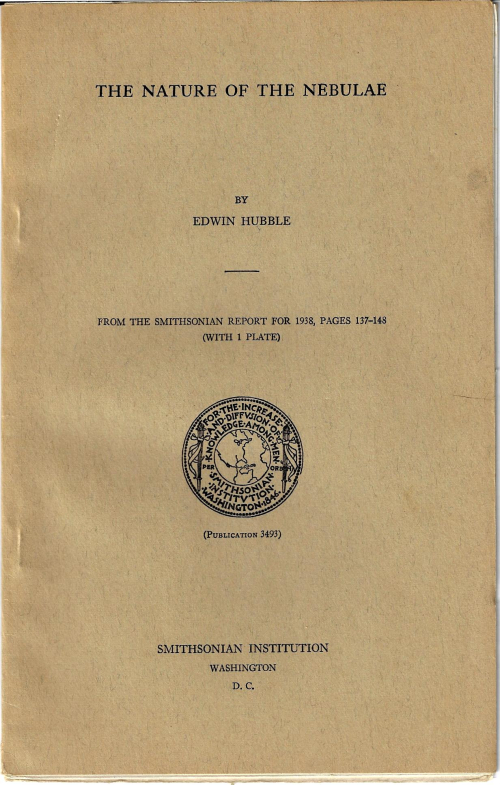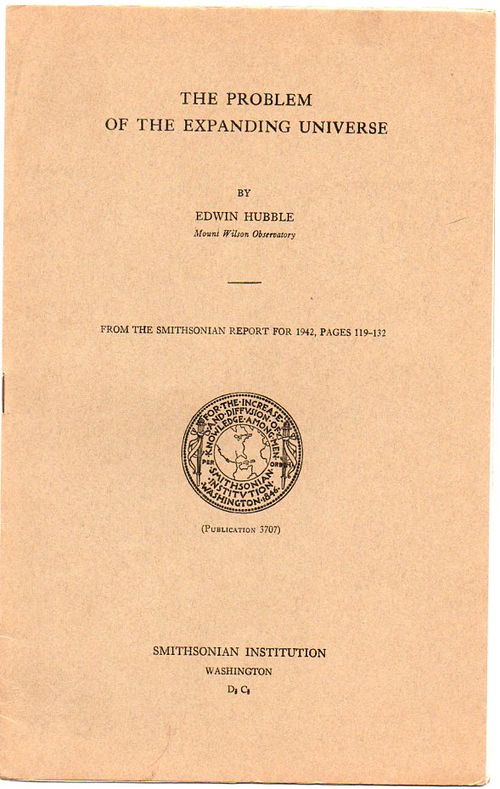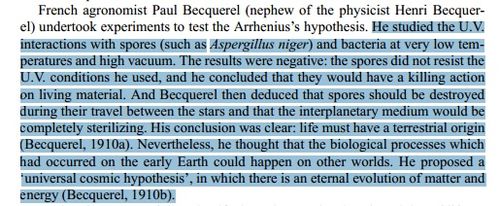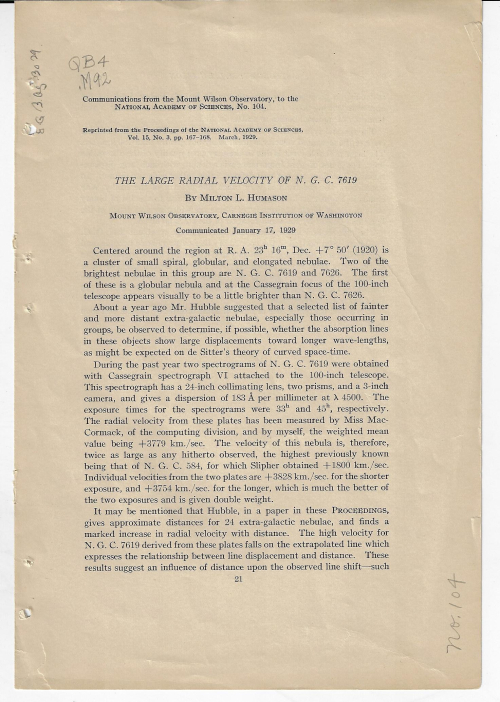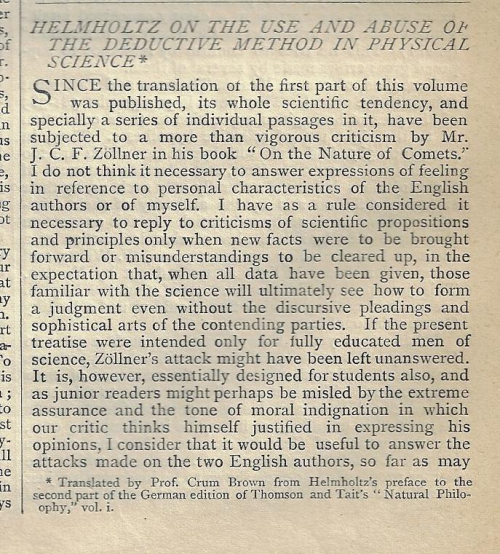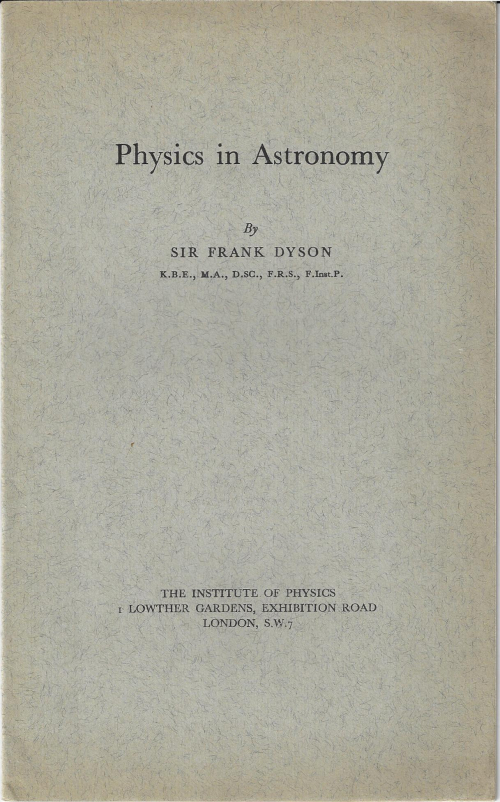(Edwin Hubble) Two contributions by the astronomer/astrophysicist/cosmologist Edwin Hubble in the Astrophysical Journal, volume 76, July-December 1932. The entire volume offered with the extra treat of the front wrapper for each of the six issues bound in. 9.5x6.5", bound in cloth, 334pp, with 14 photo plates on glossy paper. This is an ex-library copy, decently bound, and in nice condition, with the following faults: call numbers are gilt stamped on the spine, the library name is rubber stamped on the text block top and bottom; there is a bookplate on the front pastedown, and each front wrapper has a red rubber stamp of the library name in the right upper corner. That said, this is fresh, rock-solid copy. $200
- Edwin Hubble, "Nebulous Objects in Messier 31 Provisionally Identified as Globular Clusters", pp 44-69, plates VII-X
On this paper from National Academy of Science's Biographical Memoirs (Hubble), 1970, page 198: "Hubble continued his detailed studies of the nearer spiral systems, and in this paper he reported the discovery of 140 "nebulous objects" in and around the Andromeda nebula. These objects he described as "nebulous stars— small, highly concentrated, round and perfectly symmetrical. . . . The observed characteristics of the objects appear to admit of but one interpretation. On the basis of structure, luminosity, diameters and colors, the objects are provisionally identified as globular star clusters. Their absolute magnitudes are systematically fainter by one or two magnitudes than the absolute magnitudes of the globular clusters in the galactic system derived from Shapley's distances." Hubble lived to learn the reason for this discrepancy: the Cepheid distance criterion as formulated by Shapley gave distances too small by a factor of two, as reported in 1952 by Baade.”
- Edwin Hubble, "The Surface Brightness of Threshold Images", in number 2, September 1932, pp 106-117.
Other contributors to this volume include Edison Pettit, Otto Struve (5), Philip Keenan, Milton Humason, and others.
And:
Paul Merrill, Milton Humason, Cora Burwell, "Discovery and Observations of Stars of Class Be: second paper", PP 156-183.
Edwin Hubble. "Effects of Red Shifts on the Distribution of Nebulae." In Astrophysical Journal, volume 84, number 5, December 1936, pp 517-555 in the issue of pp 481-622. The issue is removed from a larger bound volume though it does have the scarce wrappers. Condition: this is a nice, fresh copy; being removed from a larger volume means that this copy does not have a backstrip cover for the spine of the wrappers. In any event, this is still probably a VERY GOOD copy. $250
“In this paper Hubble added two additional groups of nebular counts to the three groups already discussed in his 1935 paper with Tolman. After a detailed analysis of the observational data, and a comparison with the theoretical models computed with Tolman, Hubble found that "the observations may be fitted into either of two quite different types of universes. If the red-shifts are velocity shifts, the model is closed, small and dense. It is rapidly expanding, but over a long period the rate of expansion has been steadily diminishing. Existing instruments range through a large fraction of the entire volume and, perhaps, through a considerable fraction of past time since the expansion began. "On the other hand, if red-shifts are not primarily due to velocity shifts, the Observable Region loses much of its significance. The velocity-distance relation is linear; the distribution of nebulae is uniform; there is no evidence of expansion, no trace of curvature, no restriction to the time scale. The sample, it seems, is too small to indicate the particular type of universe we inhabit.”--National Academy of Sciences, Biographical Memoirs, 1970
Edwin Hubble. "The Luminosity Function of Nebulae. 1. The Luminosity Function of resolved Nebulae as Indicted by their Brightest Stars”. In Astrophysical Journal, volume 84, number 2, September 1936, pp 158-179 in the issue of pp 113-240. The issue comes with the original wrappers, removed from a larger bound volume. Condition: this is a crisp copy, though being removed it has no spine backstrip; also, the front wrapper is detached. Good copy. $150
"Consider all the nebulae in a given volume of space," Hubble wrote in The Realm of the Nebulae (p. 59). "The relative numbers of giants and dwarfs and normal objects—more precisely, the frequency-distribution of absolute magnitudes (candle powers) among these nebulae—form the 'luminosity-function.' It was assumed that the luminosity-function remains constant throughout the regions covered by the surveys—that the function is independent of distance or direction—that the giants do not tend to congregate in one region and the dwarfs in another region. The assumption has not been fully established by direct observations, but it seems reasonable and it is consistent with all information available at the present time." In this paper Hubble attempted to estimate the luminosity function for the nebulae, and he did so by two separate methods: (1) the luminosity function of resolved nebulae as indicated by their brightest stars, and (2) the luminosity function as indicated by residuals in velocity-magnitude relations...”--National Academy of Sciences, Biographical Memoirs, 1970
Hubble, 1939
Edwin Hubble, "The Nature of the Nebulae", offprint from the Smithsonian Report for 1938, pages 137-148, with one plate), publication 3493. Published by the Smithsonian Institution in Washington, D.C., 1939. 24cm.
Original wrappers. Very fine condition, and save for a faded 5mm blemish on upper front cover right corner, in nearly new condition. $95
“Hubble was the founder of modern extragalactic astronomy and the first to provide observational evidence for the expansion of the universe Hubble was the first to introduce a significant classification system for galaxies He presented this at the meeting of the International Astronomical Union at Cambridge, England, in 1925 and it was published the next year in the Astrophysical Journal... The classification was essentially empirical and independent of any assumptions concerning the evolution of galaxies. ..”
“Despite the advance in knowledge in the last forty years, Hubble’s claim to have introduced order into the apparent confusion of nebular forms and to have shown that galaxies are closely related members of a singly family stands. It must be regarded as one of his most significant achievements.
By 1929 Hubble had obtained distances for eighteen isolated galaxies and for four members of the Virgo cluster. In that year he used this somewhat restricted body of data to make the most remarkable of all his discoveries and the one that made his name famous far beyond the ranks of professional astronomers.”
Hubble's (and Humason's ) observations on the greater distances of fainter galaxies...”Hubble’s law was extended to a distance of over 100 million light-years, the straight-line relationship between velocity and distance being maintained. This result has come to be generally regarded as the outstanding discovery in twentieth-century astronomy. It made as great a change in man’s conception of the universe as the Copernican revolution 400 years before. For, instead of an overall static picture of the cosmos, it seemed that the universe must be regarded as expanding, the rate of the mutual recession of its parts increasing with their relative distance....”--DSB
The Problem of the Expanding Universe, 1943
In his great summary (The Problem of the Expanding Universe) of the development of the velocity-distance relation, the Big Bang and all that, Edwin Hubble offers concise appraisal of the research to this point (in which Hubble and his assistant Milton Humason were prominent members of its founding studies). Hubble provided the first experimental data supporting the expanding universe theory of Georges Lemaitre's cosmology (the "hypothesis of the primeval atom"), Einstein's GRT and the mathematical equations of Alex. Friedmann, finding that the distance of galaxies were proportional to their redshifts (Hubble's Law, 1929). The whole thing enjoyed a bigger, more explosive life once it had been given its more provocative and user-friendly name by Sir Fred Hoyle, who called the idea "the Big Bang" in 1949. (Sir Fred was actually attacking the idea and must've thought his tag was to be demeaning, but as a proponent of the steady state theory, Hoyle's plan backfired, a proof that irony exists.) The steady state model was more or less put to sleep when the cosmic microwave background radiation (first proposed by George Gamow, Ralph Alpher and Robert Herman in 1939) was "discovered " in 1964 by Penzias and Wilson, this providing further experimental confirmation for the Big Bang hypothesis.
"Meanwhile, on the basis of the evidence now available, apparent discrepancies between theory and observation must be recognized. A choice is presented, as once before in the days of Copernicus, between a strangely small, finite universe and a sensibly infinite universe plus a new principle of nature."
It is an excellent approximation for a semi-general-public speech (to the Smithsonian Institution crowd during the war in 1943), and reminds me of one of his other, similarly spot-on statements, one of the greatest understatements in 20th century astrophysics The statement appears in a further report on Hubble/Humason studies in The Velocity-Distance Relation Among Extra-Galactic Nebulae (Mount Wilson Observatory, 1931) , a regarding their understanding of the phenomena and the expanding universe, the authors take many steps back, and say in the concluding paragraph:
"...the writers are constrained to describe the apparent velocity-distance displacements without venturing on the interpretation and its cosmological significance".
They basically lay out the functioning of the universe and the best understanding of how we got to where we are in the cosmos (Vesto Slipher notwithstanding), and how according to their understanding that the universe is expanding and is consistent with all known laws, that they decide to not say anything, um, philosophical, in the light of disrupting the idea of the creation of all things.
Hubble did have a way with words, his own way, though he was able to communicate a difficult series of ideas simply, as we can see in the opening of his Expanding Universe paper:
"Mathematicians deal with possible worlds, with an infinite number of logically consistent systems. Observers explore the one particular world we inhabit. Between the two stands the theorist He studies possible worlds but only those which are compatible with the information furnished by observers. In other words, theory attempts to segregate the minimum number of possible worlds which must include the actual world we inhabit. Then the observer, with new factual information, attempts to reduce the list still further. And so it goes, observation and theory advancing together toward the common goal of science, knowledge of the structure and behavior of the physical universe."
And this lovely summation:
"Current theory starts with two fundamental principles : general relativity and the cosmological principle. General relativity states that the geometry of space is determined by the contents of space, and formulates the nature of the relation. Crudely put, the principle states that space is curved in the vicinity of matter, and that the amount of curvature depends upon the amount of matter. Because of the irregular distribution of matter in our world, the small scale structure of space is highly complex. However, if the universe is sufficiently homogeneous on the large scale, we may adopt a general curvature for the universe, or for the observable region as a whole, just as we speak of the general curvature of the earth's surface, disregarding the mountains and ocean basins. The nature of the spatial curvature, whether it is positive or negative, and the numerical value, is a subject for empirical investigation."
"The second, or cosmological principle is a pure assumption – the very simple postulate that, on the grand scale, the universe will appear much the same from whatever position it may be explored. In other words, there is no favored position in the universe, no center, no boundaries. If we, on the earth, see the universe expanding in all directions, then any other observer, no matter where he is located, will also see the universe expanding in the same manner. The postulate, it may be added, implies that, on the grand scale, the universe is homogeneous and isotropic – very much the same everywhere and in all directions."
"Modern cosmological theory attempts to describe the types of universes that are compatible with the two principles, general relativity and the cosmological principle. Profound analysis of the problem leads to the following conclusions. Such universes are unstable. They might be momentarily in equilibrium, but the slightest internal disturbance would destroy the balance, and disturbances must occur. Therefore, these possible worlds are not stationary. They are, in general, either contracting or expanding, although theory in its present form does not indicate either the direction of change or the rate of change. At this point, the theorist turned to the reports of the observers. The empirical law of red shifts was accepted as visible evidence that the universe is expanding in a particular manner and at a known rate. This arose the conception of homogeneous expanding universe of general relativity."
I like Hubble.
Notes:
The paper begins:
"I PROPOSE to discuss the problem of the expanding universe from the observational point of view. The fact that such a venture is permissible is emphatic evidence that empirical research has definitely entered the field of cosmology. The exploration of space has swept outward in successive waves, first, through the system of the planets, then, through the stellar system, and, finally, into the realm of the nebulae. Today we study a region of space so vast and so homogeneous that it may well be a fair sample of the universe. At any rate, we are justified in adopting the assumption as a working hypothesis and attempting to infer the nature of the universe from the observed characteristics of the sample. One phase of this ambitious project is the observational test of the current theory of the expanding universes of general relativity. "

